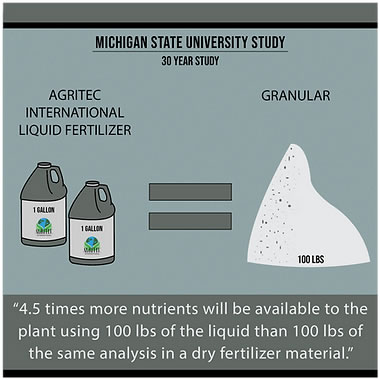Bio-activated Liquid Calcium
Liquid Calcium Vs. Granular
Everything you need and nothing you don’t. That’s what you get with AgriTec Liquid Calcium Plant Foods. Formulated from the finest quality of raw materials, AgriTec’s Plant Foods are free of the impurities, chlorides, and heavy metals that are common in today’s leading brands. AgriTec gives your plants the ultra-pure nutrients they require without the harmful fillers. AgriTec Foods are environmentally safe, non-toxic, non-corrosive, and are formulated with a neutral pH.
Six gallons per acre of a 10-20-10 liquid plant food weighing 11.4 pounds per gallon will weigh about 68 pounds. Assuming an availability of 90%, the plant would receive about 61 pounds of fertilizer per acre. Further breaking this down in terms of N, P, and K, the plant should receive and use 6.1 pounds of Nitrogen (10% N), 12.2 pounds of Phosphorus (20%), and 6.1 pounds of potash (10% K).
Dry granular fertilizers are using less costly raw materials that are toxic to the plant and must be applied to the soil, which in turn gives it over to the plant. Normally, much efficiency is lost in the process due to weather conditions and the chemical make up of the soil tending to the “tie-up” nutrients. As a result, nearly all the universities have found the availability of dry fertilizers to average between 10 and 20%. Typically, 300 pounds of a dry 10-20-10 fertilizer applied to the ground would find only 60 pounds (20% of 300lbs) actually becoming available to the plant during the growing season.

As can be seen from the above calculations, 6 gallons of AgriTec’s Orthophosphate Liquid Plant Food would provide as much nutrition to the plant as 300 pounds of a dry fertilizer. Actual expense figures usually show AgriTec’s Liquid Plant Foods saving from 15 to 30% over dry fertilizer costs per acre. So, why buy what you can’t use or might lose? Buy the best and save the most with AgriTec’s Plant Foods. For specific recommendations and pricing, contact AgriTec at (833) 247-4832.
How It Works
AgriTec’s products Pro-Cal and Advanced-Cal are both Bio-Active Liquid Calcium products, designed to raise soil pH, balance soil base saturation, and build overall soil health. Liquid Calcium as a replacement to liming is generally a new concept, this article will help to better explain just what liquid calcium is and how it works.
History of Bio-active Liquid Calcium
Using liquid calcium for agriculture purposes is not something that was just developed, but rather has been used, and researched for the past 65 years or more. One of the first notable experiments into liquid calcium and its ability to affect soil and plant growth was done in 1938 by two soil scientists named William Albrecht, and Thomas McCalla, which showed how crucial calcium in the soil was to plant growth and production. Since those experiments, countless studies have been conducted showing the importance of calcium to the soil, the plant and just how vital it is to plant health and growth.
Where does Liquid Calcium come from?
Bio-Active Calcium initially is mined from the ground in the same way that limestone is extracted and pulverized. But unlike limestone, the process does not stop there. The crude material then goes through a process of heating, liquifying and then extracting the pure soluble liquid calcium, doing away with all the sediment that would normally end up in your soil, and chelating the calcium to make it ready for agriculture use. The raw calcium is then mixed with carrying agents, surfactants, and chloride to make the ease of application and delivery simple and very effective. Chloride in this small amount is proven to increase photosynthesis in the plant creating faster and stronger growth, and also increasing drought resistance and disease resistance and suppressant.
It is very important to take note that chloride in this form is not the same as the crude calcium chloride used on roads and in tractor tires. Just like some forms of lime are used for hardening soil before construction, or to be mixed with concrete, there is a distinct difference and importance in understanding ag grade products meant for agriculture purposes, and crude material used for construction or in tires.
University backing of Liquid Calcium
AgriTec has land grant university research from multiple universities showing how calcium changes soil pH, and just how crucial and important calcium is to the soil and to the plant. AgriTec continues to conduct studies and build further evidence that calcium is more effective than dry lime and raising soil pH and improving soil conditions.
Importance of Calcium in the plant
Having proper calcium levels in the soil has an enormous impact on a plant’s health, and most importantly its ability to grow and produce. Calcium plays 2 very crucial rules in the plant. The first being that calcium makes up the cell wall inside every plant. Much like humans, our bones are made from calcium, the plant is no different. Calcium is the skeleton of the plant and is responsible for protecting against disease and bacteria that can hurt or kill a crop.
The second crucial role that calcium plays in the plant is cell division. As a plant grows each cell divides into new cells, which divide again and again. The catalyst for this process is calcium. Without calcium cells won’t divide, new cells won’t form, and the plant won’t grow. If you are dealing with terminal growth in your crops, it is due to a lack of available calcium in the soil. Having low calcium levels can mean slower growth, greater risk for disease, and poor crop production.
Base saturation and how it effects soil pH
Base saturation is something more often than not too quickly overlooked on a soil test. What base saturation shows is the percentage quantity of calcium, magnesium, potassium, and hydrogen in the soil. The lower the saturation gets for calcium and magnesium the more nitrogen will build up in the soil. This is what causes a pH to become acidic. That hydrogen is blocking the movement of nutrients in the soil and to the plant that in turn hinders growth, and causes the fertilizer to become bound up and go to waste.
The optimal levels for base saturation are 65-75% Calcium, 15% Magnesium, 2-4% Potassium, and about 10-15% hydrogen. At these levels, soil pH is balanced right around 7.0 neutral state. But, most importantly, the nutrients in the soil such as nitrogen, phosphorous and all the key elements of plant growth. When the base saturation is balanced the cation exchange in the soil is at its most efficient. Additionally, when these levels are balanced soil is more porous, meaning there is less compaction, better water disbursement, and retainment of that water, which leads to a healthier stronger crop. Essentially the base saturation of calcium and magnesium in the soil is directly correlated to soil pH, hence the reason for using calcitic lime or dolomitic lime.
Importance of Calcium in the soil
Base saturation is something more often than not too quickly overlooked on a soil test. What base saturation shows is the percentage quantity of calcium, magnesium, potassium, and hydrogen in the soil. The lower the saturation gets for calcium and magnesium the more nitrogen will build up in the soil. This is what causes a pH to become acidic. That hydrogen is blocking the movement of nutrients in the soil and to the plant that in turn hinders growth, and causes the fertilizer to become bound up and go to waste.
The optimal levels for base saturation are 65-75% Calcium, 15% Magnesium, 2-4% Potassium, and about 10-15% hydrogen. At these levels, soil pH is balanced right around 7.0 neutral state. But, most importantly, the nutrients in the soil such as nitrogen, phosphorous and all the key elements of plant growth. When the base saturation is balanced the cation exchange in the soil is at its most efficient. Additionally, when these levels are balanced soil is more porous, meaning there is less compaction, better water disbursement, and retainment of that water, which leads to a healthier stronger crop. Essentially the base saturation of calcium and magnesium in the soil is directly correlated to soil pH, hence the reason for using calcitic lime or dolomitic lime.
How Liquid Calcium raises soil pH
Soil pH is a measure of the acidity in the soil. That acidity is determined by the amount of the hydrogen (H+) build up in the soil. Hydrogen is an acidic cation whereas calcium and magnesium are basic cations. Balancing soil ph is simply balancing the levels of the cations at a state that maximizes nutrient availability in the soil. Soil is the nutrient storhouse for plants. We measure the cation amounts in the soil based on a 100% soil capacity, such as discussed in the base saturation section. The higher the percentage of Hydrogen in the soil compared to other primary cations, calcium and magnesium, the lower the soil pH becomes. However, when calcium or magnesium are added to the soil it raises each of their respective percentage levels, in turn lowering Hydrogen levels and raising soil pH.
Example:
Soil pH: 5.5
Base Saturation Levels:
Ca++ : 50% Mg++ : 12% K+ : 3% H+ : 35%
If Calcium is added to soil soil to raise the calcium base saturation by 25% to the necessary level, the following result will occur:
Soil pH: 6.8
Base Saturation Levels:
Ca+ : 75% Mg+ : 12% K+ 3% H+ : 10%
Notice the difference being the additional 25% calcium introduced to the soil lowed the overall percentage of hydrogen by the same quantity. In turn balancing pH at a neutral or near neutral state.
Liquid Calcium works by quickly and effectively adding the needed calcium to the soil raising base saturation and balancing pH. This is what is happening when a calcitic lime is added to the soil. The difference being the limestone must take 6 months – 1 year to break down. During this time the stone is releasing soluble calcium into the soil and raising pH. However, only a small percentage of limestone actually becomes available calcium, with the majority settling out in the soil causing hard plates and soil compaction over time.
Liquid Calcium eliminates those issues, by bypassing the breakdown process, and eliminating harmful sediment that can hurt soil conditions in the long term. To put this simply, limestone and Liquid Calcium in the end administer the same results, which is adding calcium to the soil to raise pH, increase Cation Exchange in the soil, rid the soil of sage weeds, and boost overall plant growth and health. Liquid Calcium is simply a more effective way of attaining those results. The reason this method seems to be new to the industry, although it is not, is because for years, it has not been cost effective to do so. However, with current day ag prices plus the cost of trucking and spreading, liquid calcium is not not only the better option for correcting soil pH, but also the more affordable option.
How Liquid Calcium is applied
AgriTec’s Bio-Active Liquid Calcium comes in a liquid concentrated state. At time of application the Liquid Calcium must be mixed with water at a standard rate of 5:1 or greater (Water : LC). The Liquid Calcium can then be applied with a standard ag sprayer, boom sprayers and single/dual point sprayers work equally well for applying calcium to the soil. AgriTec’s Bio-Active Liquid Calcium is ag grade, meaning it is safe for ag equipment, and will not corrode or plug up sprayer systems. AgriTec’s Liquid Calcium can be applied through numerous other methods, such as irrigation systems (pivot sprayers etc.), or by airplane. More in depth mixing instructions and application instructions can be supplied by your local AgriTec soil rep.
How quickly does Liquid Calcium work and longevity
AgriTec’s Bio-Active Liquid Calcium is immediately available to the soil upon application. The product is rain fast in 6 hours and is typically working its way into the soil right away. However, soil always takes some time to absorb new nutrients, so typically a period of about 30 days is needed for soil levels to adjust and pH to become balanced.
Calcium is meant to store in the soil from season to season. Whether introduced through a liquid form or dry lime, calcium is slowly used up by the plant. What this means is liquid calcium typically only needs to be applied every 3+ years. Regardless, it is important to keep up with soil conditions by regularly taking soil test, and is always the most beneficial way of knowing when liquid calcium needs to be re-applied.
What is C.E.C.?
For a comprehensive explanation of C.E.C. please see this article written by the Ag Extension Office of the Purdue University: https://www.extension.purdue.edu/extmedia/AY/AY-238.html


